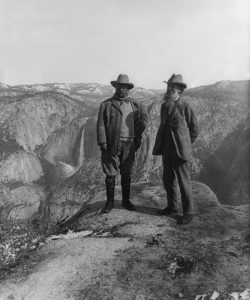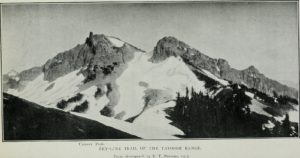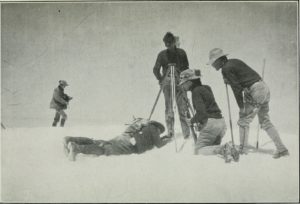John Muir didn’t like organizations of any kind—churches, political parties, clubs, even nations. Although he lived in the U.S. for most of his life, he never really thought of himself as belonging to the country. He listed his address as “earth-planet, universe.” He only became a U.S. citizen late in life to obtain a passport needed for international travel (learn more about John Muir here).
He made one exception to his policy of avoiding groups, and he did so in a big way. On May 28, 1892, Muir joined a small group of fellow Californians to create what is now the largest grassroots environmental organizations in the world—the Sierra Club.

Muir had pondered starting an organization of like-minded wilderness lovers for some time, encouraged by many of his friends. But he resisted, guided by his firm avoidance of people gathered into groups. Preserving his beloved Sierra Nevada Mountains, however, proved more powerful than his urge to stay unaligned. And so, led by J. Henry Senger and a group of students at the University of California-Berkeley, Muir and a few others founded the Sierra Club.
The club’s purpose was “to explore, enjoy, and render accessible the mountain regions of the Pacific Coast; to publish authentic information concerning them; and to enlist the support and cooperation of the people and government in preserving the forests and other natural features of the Sierra Nevada.” John Muir became the club’s first president, serving until his death in 1914. The club’s charter members numbered 182, many of them scientists. The club began publishing the Sierra Club Bulletin in 1893, which continues to this day as the magazine Sierra.

Almost immediately, the club began influencing conservation affairs. It fought successfully against shrinking the borders of Yosemite National Park and for the protection of other western scenic icons—including the Grand Canyon—as national parks and monuments. Working alongisde John Muir, it lost the fight to protect the Hetch Hetchy Valley in Yosemite from damming, a heartbreak that is often cited as a prelude to Muir’s death (learn more about Hetch Hetchy here).
A major early feature of the club was a series of annual mountaineering excursions. Originally, it was an “alpine club,” organized around the interests of those who loved to explore the high mountains. The founders, including Muir, understood that bringing novices into the mountains, for a gentle but authentic experience, would help build public support for conservation. For years, Muir himself led the annual outings that became a signature of the club. The Sierra Club has continued this practice, with the goal of getting people out of the city and into nature. Today, the club sponsors more than 20,000 outings per year.

Until the 1950s, the Sierra Club remained largely focused on California and adjoining states. But with growing national environmental interest, the club expanded its programs to cover the entire nation. In 1951, the club restated its purpose, now with the intent “to explore, enjoy and preserve the Sierra Nevada and other scenic resources of the United States.” Under the entrepreneurial leadership of David Brower, the club began a long-term relationship with wilderness photographer Ansel Adams, producing books, calendars and other artworks (learn more about Ansel Adams here). Now, the beauty of nature could travel to the homes of the nation, as well as the nation travelling to them.
The club has since become the largest and most well-known environmental organization in the world. It counts 3 million members and supports in 64 local chapters located across the U.S. and around the world. The club’s headquarters remain in San Francisco, but in 1963 it opened an office in Washington, DC, to allow access to federal agencies and lawmakers. The club has taken on a broader environmental agenda, recognizing that pollution was as big a threat to nature as was direct development. The club continues to lobby for land protection, but also for clean air, clean water, and reduction of our dependence on fossil fuels.
References:
Cohen, Michael P. 1988. The History of the Sierra Club: 1892-1970. Sierra Club Books. Excerpt available at: https://vault.sierraclub.org/history/origins/. Accessed May 28, 2018.
Encyclopedia Britannica. Sierra Club, American Conservation Group. Available at: https://www.britannica.com/topic/Sierra-Club. Accessed May 28, 2018.
Sierra Club. About the Sierra Club. Available at: https://www.sierraclub.org/about. Accessed May 28, 2018.
